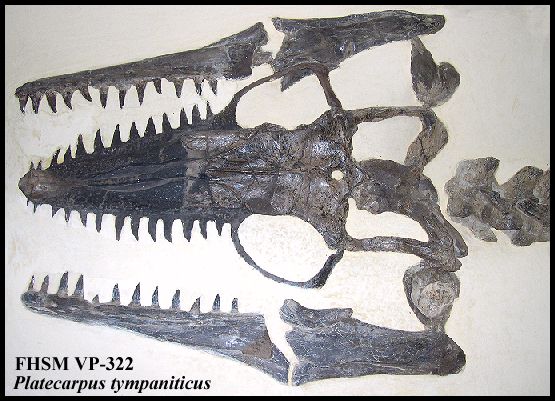A
Kansas Mosasaur.
Editor POPULAR SCIENCE:
There are three well-defined genera of the Mosasaurs found in the chalk of western
Kansas.
The giant of his race, Tylosaurus,
reached a length of nearly 50 feet. The next in point of size and power was the genus Platecarpus, with four
broad paddles. The last is Clidastes,
a smaller and more elegantly built reptile, with well developed additional articulations
in the vertebral column, that enabled it to coil up like a serpent. All these reptiles had
long conical heads terminating in a heavy, bony snout. In Platecarpus this is blunt, but in the other genera
they are long and conical; and Cope believed they were used as a battering ram against
their foes.
A short neck of seven
vertebrę characterizes all these reptiles; behind which were the scapular arches, from
which were suspended the fore paddles, that consisted of the hands with five fingers,
between which a membranous web was spread. They all had hind paddles attached to the
pelvic arch, similar to the front ones, behind which was an elongated tail of many
vertebrę that gradually decreased in size, so that the last one was a mere button, quite
small, with no processes. They resembled both the snakes and lizards. Owing, however, to
the presence of the limbs many paleontologists place them among the lizards. Hence the name—a lizard of the river Meuse.
Last year, while I was
making one of my annual expeditions in search of fossil vertebrates in the chalk of Plum
Creek, Grove [sic] County, Kan., my son George, a boy of 14 years, showed me three caudal
vertebrę of a Platecarpus lying on a narrow
ledge in a low wash in the yellow chalk. As the caps [cups] of the vertebrę pointed into
a low mound, and, no fragments were protruding from the opposite ravine, the hope at once
rose that I might be able to procure the whole skeleton, except, of course, the caudals
that had been cut away by the wash along which those first seen were lying, in case the
animal had died a natural death, and was not torn to pieces by the other voracious
reptiles and fishes that so thickly patrolled the waters of his day, in search of food.
Since 1875, 1 have
explored, year after year, the famous chalk of Kansas, and have collected hundreds of the
denizens of the old cretaceous ocean, whose scattered remains lie buried there. From many
bitter disappointments I knew, however, that this specimen like many others might, after I
had spent days of heavy labor in uncovering the floor on which it lay, prove to be only a |
few
scattered bones torn from an animal by one who was fighting for his dinner, but was forced
to drop it and fight another who also wanted it, and the consequence was it fell to the
bottom of the sea. We find paddles here, skulls there. But a perfect skeleton is rare
indeed. These great reptiles, fishes, birds and pterodactyls, lived during the age
of reptiles, before the mammals with gentler instincts arrived on the stage of the
world’s upward march towards higher and better types. They were all flesh-eaters and
doubtless devoured their own offspring. The results of many battles I have seen in the broken ribs and other bones that have reunited. The most
famous one I am familiar with is recorded in a Platecarpus
discovered by Dr. Williston’s expedition of last year, for the
Kansas University. It
was one with a whole scapular arch and part of the arm, that had been crushed so badly by
the ram of an enemy that all the bones in healing had become so mixed and distorted that
it was impossible to recognize the separate bones.
With the hope mentioned we
bravely attacked the mass of chalk that lay above the level of the bones. A fierce hot
wind was parching the buffalo grass of the prairies, and howling through the canyons with
remorseless fury, filling our eyes with fine dust that burned them like fresh slacked
lime, and the sun with fervent beat was heating the naked chalk in the bit of bad lands in
which the specimen lay, so hot we could hardly endure it. We labored for two weeks in
taking out and packing this specimen. Owing to the curved position of the vertebral
column, we had to lay bare a floor 9 x 16 feet. The average thickness of rock removed was
about three feet of tough tenacious chalk that could only be chipped off little by little
under the blows of our heavy picks. When very dry, however, our picks crushed into it like
cutting into loaf sugar. When in this condition, water thrown on it causes it to
effervesce, as if acid had been used.
After the hot floor was
laid bare my special work as a skilled collector began, and to me that floor was holy
ground. I took off my shoes and stretching myself at full length upon it, began with a
small awl to follow up the lateral spines of the vertebrę that projected upward, only
uncovering enough to trace the bones so that I might not injure them in cutting out the
slabs. This column, from where it entered the rock, was absolutely perfect and in position
for nine feet. Then, to my sorrow, I found that the rest of the |

